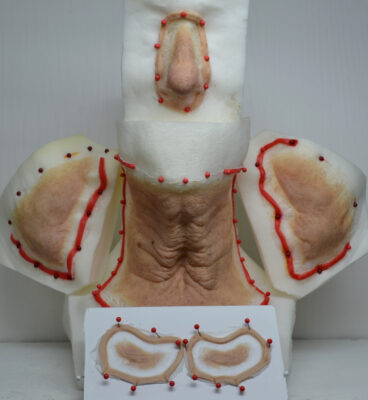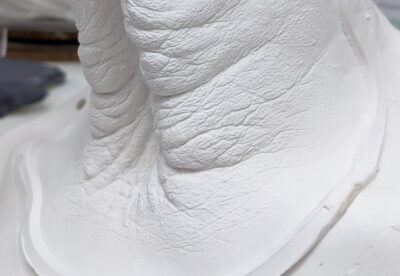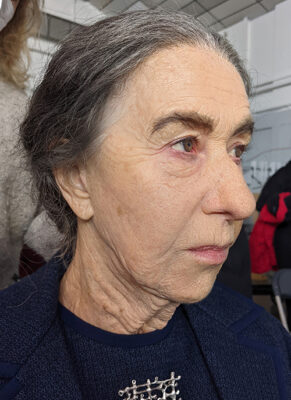
Copyright by Suzi Battersby. Provided by Scott Essman
In the long history of prominent movie makeups, one of the most daunting of challenges is the likeness makeup, where an artist on a film is mandated with creating a realistic depiction of a person of note from history. Other makeup challenges such as monster makeups, age makeups on youthful actors, and animalistic makeups are surely formidable; likeness makeups are often further scrutinized by an observant public and require even greater precision than the former types. Thus, two of the five films were Oscar nominated this season for their accuracy in depicting historical figures, well-known to the public, though the artists involved had a further disadvantage in that their subjects were not among the living.
After two-time Oscar-winning makeup designer and artist Kazu Hiro received an inviting text from director/star Bradley Cooper, his journey in recreating five Leonard Bernstein age stages — from 25-years-old to 71-years-old — began on Maestro. “Leonard Bernstein was a big inspiration when I was kid, so I wanted to do the film,” Kazu stated of the musical composer and conductor. “I started to gather reference images and video and books of Lenny. I picked good images of each stage and sent it to Bradley. We talked about how to age him in these different stages.”
Where modern artists are known to design makeups with the use of computer programs including Z-Brush, Kazu positions himself as older school. “I started to use a scanner to do a head cast of Bradley,” Kazu revealed. “It still doesn’t get as much detail compared to a physical head cast, but it’s pretty close. And then on that, I printed out the head cast in the 3D printer, and then made a copy in plaster, and the design of the makeups in oil-based clay. I like the feel of the clay, and the sense of the dimension is better in physical form, rather than in a computer.”

Copright 2023 by Netflix. Image provided by Netflix
Fortuitously, Cooper contacted Kazu just before the onset of the national quarantine in 2020, giving Kazu ample time to prepare the appliance-based prosthetic makeups and shoot tests both at his makeup studio and a film test at the Walt Disney Concert Hall in downtown Los Angeles. “We never usually do a makeup test in an actual location—usually it happens corner of the studio,” Kazu said. “I did makeup tests on him—five different stages in two days; Bradley got Paul Thomas Anderson to film it. A few months before filming, we did another film test. Then, we went into the filming of the movie.”
For each of the five age stages for Bernstein, Kazu sculpted different nasal appliances for Cooper. “For his youngest stage, Cooper had a nose, and a nose plug, because we had to widen Bradley’s nose,” Kazu detailed, working completely with the prosthetic material of silicone. “He also had lips because, as Lenny aged, his lips got thinner. He had a full lip when he was youngest. And he had a chin piece and significant ears—we had a plastic piece to push out the ears.”

Provided courtesy of Suzi Battersby.
All five Bernstein age stages comprised of the earpieces and nose plugs, and all included a wig. Kazu’s first and second stages involved a prosthetic pieces for the nose, lips, and chin. For the third and fourth stages, Kazu added cheek and neck appliances, while the fifth and last stage found Cooper covered in prosthetics all over his face, head and neck: a top-of-the-head prosthetic piece, a forehead, eyelids, cheeks, nose, upper lip, lower lip, neck and shoulder, and the back of the neck. In an uncommon but critical decision, for the fifth stage, Kazu created arm appliances, including a top piece and bottom piece. For only one scene, Cooper’s shirt was open, so Kazu fashioned a silicone suit with a belly and chest piece. On Maestro, Kazu hired Vincent Van Dyke to make the molds and run the silicone appliances.
As Cooper requested that Kazu be on the Maestro set all throughout production, over 50 shooting days, Kazu applied the makeups himself, with the assistance of Megan Longmeyer, who helped with organization and cleanup. For the oldest-age stage, Kazu had two assistants helping him to apply arms while he worked on Cooper’s face. Moreover, Kazu designed the wig, which was ventilated by Diana Choi and dressed/affixed by Lori McCoy-Bell. Where the first two makeup stages took approximately two hours to fully apply, the third and fourth stages were close to a three-hour process; the entire fifth stage process took five hours to complete and was executed three times during principal photography.

Copright 2023 by Netflix. Image provided by Netflix
Following the application of a standard bald cap on Cooper, for that monumental fifth stage, begun at 1:30am, Kazu then applied the shoulder, neck piece and cheek piece, nose, top-of-the-head, the forehead and eyebrows, then an upper lip, lower lip and chin. “It was tough because he wanted me to do it by myself,” Kazu unveiled. “That’s the other reason it took longer. You know, if I have another person working the other side of the face — when I’m working on a right cheek, someone can work on the left cheek… we attempted it, but Bradley said, ‘Oh, no, no, no.’”
According to Kazu, Cooper noticed everything that occurred when he was in the makeup chair. “If something was wrong, he noticed right away,” Kazu recalled. “For example, if a piece was off a little bit, he can tell right away. Some actors, they don’t pay attention, but he could tell. He even noticed if the stiffness of the piece was a little bit different after I apply lips: ‘This feels different from yesterday.’”

Provided courtesy of Suzi Battersby.
To give Cooper the final old-age look after the appliances were on, Kazu meticulously painted the appliances, considering both Bernstein’s darker complexion and the amount of activity he undertook, especially in scenes where Bernstein was duly animated while conducting an orchestra. “I tried to make it so the makeup will last a long time,” Kazu noted. “Bradley was very respectful to the makeup—he wanted to show up as a Lenny on set when cast and crew came in. After we finished the makeup, there was a few hours before filming, so it was kind of scary. He didn’t want many crew coming into the set while he’s setting up the shoot of that day, so we are waiting in the makeup trailer, and when they’re ready to film, we had to go right away to check everything. It was kind of tricky, but it was an amazing experience.”
For the independently-produced, modestly-budgeted Golda, hair, makeup, and prosthetics designer Karen Hartley met with director Guy Nattiv only six weeks before filming began on the project, to conceptualize the recreation of Israeli Prime Minister Golda Meir in 1973, during the time of the Yom Kippur War. Immediately, Hartley brought in prosthetics designer Suzi Battersby to spearhead the titular makeup for star Helen Mirren who would perform as Meir at age 75.
In record time, a 3D scan was taken of Mirren head and face, while Hartley designed the wig and eyebrows for the character. Amazingly, Battersby had just over four weeks to fashion the prosthetics that Mirren would require, while the aforementioned Vincent Van Dyke, in the Los Angeles area, created the 3D scan and lightweight resin printout of Mirren’s face—with eyes open—and head, including her shoulders.
Thereafter, Hartley recollected that she reviewed footage of Meir with Nattiv and Nicholas Martin, the screenwriter. “You look at footage, you look at photos, anything really you can get your hands on,” she said. “I always say it’s more about how Helen will lend herself to it. You have to go with the face in front of you and go for the silhouette of Golda, rather than just imprinting that face on Helen’s face.”

Provided courtesy of Suzi Battersby.
In conceiving Mirren’s prosthetics, Battersby relayed that she absorbed reference imagery from throughout Meir’s life. “I found it quite useful to deliberately look at photos of Golda when she was younger and compare them with Helen when she was younger,” Battersby stated. “It’s really important to see where their anatomy actually matches and where it doesn’t, because I think the signs of aging can get in the way of that. I found that that was useful in conjunction with the photos of Golda at the time. It wasn’t about just sticking a Golda on top of Helen. It was about bringing the two of them together to meet somewhere, so it actually feels authentic.”
With no time to spare, Hartley and Battersby would liaise with Nattiv; Battersby came up with a sculpture to show Nattiv, Martin, and Mirren. After an initial makeup test, slight changes were made for subsequent tests. Under her Red Girl makeup studio banner, Battersby sculpted the makeup that would go in front of camera. “A lot of it had to be driven, from my point of view, by instinct,” Battersby said. “Having to work that fast, I felt very confident knowing what was going to work and what wasn’t going to work. It made it even more important to keep it to a less is more approach. It’s interesting, because it is a dramatic transformation.”
Deliberately, Hartley and Battersby relegated the appliances to only cover half of Mirren’s cheeks, and leave appliances off of Mirren’s forehead. Eye bags, a nose, and a front half of the neck were fashioned as appliances; a chin appliance was created but never used. “The last thing we wanted was to create something that was going encumber Helen so much that she couldn’t do her job,” Battersby confessed. “Karen and I were having conversations quite frequently when we kept looking at the photos and talking about it. I knew that the appliances would work all together. We had to get the sculpt done in a week, so that we could get on with molding it.”
Especially given such limited available time, in makeup tests, Hartley and Battersby agreed to try one appliance, then add more, bit by bit, to see how much was needed to get to the best possible likeness of Meir. “It was quite an interesting process to make all those decisions very quickly in that first week, and then commit to it as a technical process to actually bring it to fruition,” Battersby explained of a makeup which encompassed two-and-a-half hours to apply and prepare.
According to Hartley, people’s perception of the Golda makeup is that it is a full-on face of prosthetics. “When you are creating something like that,” Hartley said in hindsight, “there’s a physicality to it as well. It was all of that coming together with Sinéad Kidao, who’s our costume designer. It has to be ‘you put things in to take them out.’ And that’s what we did — it’s so much simpler than people think it is; it comes together very well because we did pare it down. It is quite a dramatic transformation on Helen, a world-renowned face, and she was very pleased with it. Actors are always a little bit reluctant to feel their performance is hiding behind the prosthetics, but Helen did definitely embrace it.”
With eight people working on the project at Red Girl in England, Battersby and her team manufactured the appliances in silicone. “We can play with the softness,” she said of the silicone. “We actually pushed it incredibly far—we mixed two products that don’t usually mix together: one, the standard silicone that a lot of people like to use: PlatSil® Gel-10. You soften it with a product called Smith’s Deader. But I like to use a different deadener, which is a low-viscosity deader, which you can push really, really far. Typically, people push it to about 200%, maybe 220%. This, we were doing at 300% because the last thing I wanted was for it to not move as well and as soft as Helen’s own skin. Helen was worried about the neck because that was the biggest appliance by quite a long way. The last thing you want is for her to feel like she’s burdened, and she can’t move. Everything else was actually very thin.”
Across 30 makeup sessions for Golda, after getting Mirren’s hair down for the eventual wig, the first hour of the process including Battersby and prosthetic artist Ashra Kelly-Blue preparing the skin and gluing down the appliances, followed by careful coloring, to bring the final application of silicone pieces to match Mirren’s skin. After Battersby finished that step, Hartley and hair stylist Annette Gray would supervise the addition of eyebrows and the wig. When Mirren’s makeup was set for shooting, Kelly-Blue would regularly return to Red Girl to create new appliances for upcoming days of principal photography.
When Mirren saw her first performance in the makeup on a monitor, she was delighted with the result. “You have to trust the filmmakers so much with your performance,” Battersby commented. “The first time Helen got to see it on camera, she was capable to do what she needed to become Golda. It looked amazing even in that first test.”
Significantly, during the first camera test, by moving her head, Mirren manipulated the neck appliance to achieve a full range of motion. “I cried when I saw Helen on camera,” said Hartley. “I was just so happy that we could have done it in time. I don’t really think we could have done any better. It is one of the most proud moments I’ve had in my career.”
Maestro makeup and hairstyling Oscar nominees for 2023 are Kazu Hiro, Kay Georgiou and Lori McCoy-Bell
Golda makeup and hairstyling Oscar nominees for 2023 are Karen Hartley Thomas, Suzi Battersby and Ashra Kelly-Blue.
Red Girl Studio Team for Golda:
Prosthetics Designer, Sculptor, Moulding and Application: Suzi Battersby
Application, Painting & Silicone Running: Ashra Kelly-Blue
Painting: Niki De Jong & Rajpar Shah
Moulding & Silicone running: Renae Taylor
Silicone running: Rachel McCloskey
Trainees: Jodie Storey & Magdalena Rosa